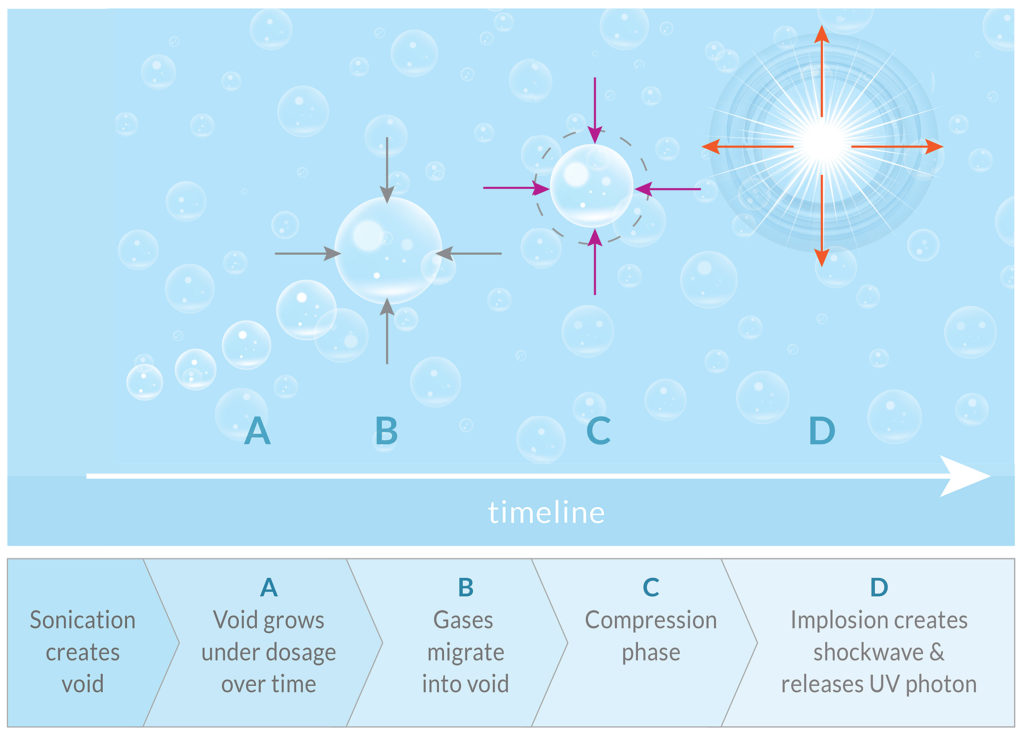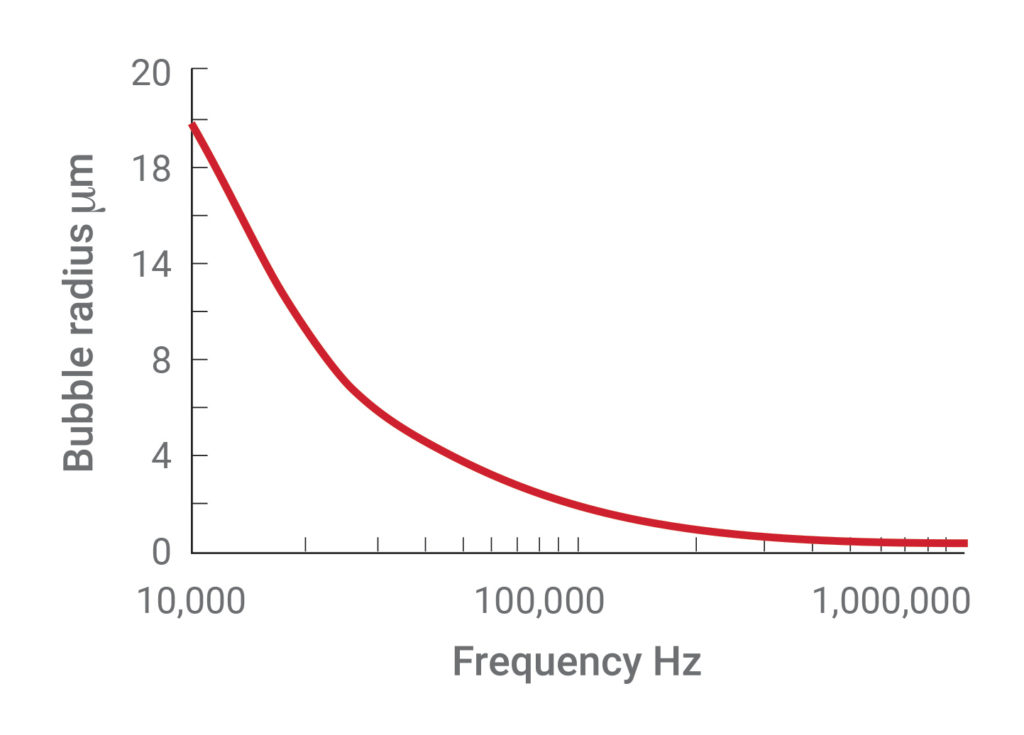Acoustic cavitation is the generation and action of cavities, or bubbles, in a liquid. When an acoustic field is applied to a liquid, sound waves move through the liquid and produce variations in the liquid’s pressure. During the low-pressure portion of the acoustic wave, if the liquid pressure momentarily drops below the liquid vapor pressure, then cavities are formed. After forming, these bubbles are set in motion by the macroscopic pressure wave.
The pressure oscillations that create the bubbles also cause them to expand and contract. These cavities quickly become filled with dissolved gasses and/or vapor of the surrounding liquid. Gasses diffuse into the bubble upon expansion and leave the bubble during contraction. If the pressure variation is great enough, any cavities that are present will grow. As the pressure range increases, bubble growth increases. If the bubble reaches a size that can no longer be sustained by its surface tension, the bubble will collapse. Figure 1 shows this cavitation cycle of the bubbles.

Bubble collapse, or implosion, is an important component of the cavitation phenomenon. Imploding bubbles generate localized shock waves, and the force of these shock waves varies with the size and content of the bubble. Larger bubbles are unstable and implode with greater force; smaller bubbles are stable and collapse with less force. Transient bubbles are mostly vapor-filled and exist for only a few acoustic cycles. Their collapse produces a powerful local jet of force and releases a photon of light (this is known as sonoluminescence). Cavities filled by dissolved gas characterize stable cavitation and grow over many pressure cycles. Less energy is released at implosion in stable cavitation.
The force produced on collapse correlates with the maximum size of bubbles, and the smaller the maximum bubble size, the less force is produced at implosion. This maximum bubble size decreases as acoustic frequency increases See Figure 2. Transient cavitation predominates when using ultrasonic frequencies, between 20 and 350 kHz. Combined with greater energy released from the collapse of larger bubbles, ultrasonic frequencies can damage the surface and any sensitive exposed features.

Megasonic frequencies, from 700 to 1000 kHz, produce stable cavitation bubbles that are sub-micron in size and have less time to grow. Both factors result in a less vigorous collapse than transient cavitations. The implosion associated with these sub-micron, gas-filled bubbles is less likely to produce surface damage. Thus, megasonic cavitation is better suited to sensitive substrates.
Acoustic cavitation is the principal mechanism for particle removal contributed by megasonic energy. If the shock wave forces from bubble collapse are great enough to overcome particle adhesion forces, particles will be dislodged from the surface. Cavitation also increases the bulk fluid flow rate through microscopic flows generated by bubble oscillation prior to collapse. These localized jet forces and microscopic flows are each components of acoustic streaming. Through both mechanisms, megasonic boosts the chemistry in removing particles from and refreshing chemistry at the surface.
| Cookie | Duration | Description |
|---|---|---|
| cookielawinfo-checkbox-analytics | 11 months | This cookie is set by GDPR Cookie Consent plugin. The cookie is used to store the user consent for the cookies in the category "Analytics". |
| cookielawinfo-checkbox-functional | 11 months | The cookie is set by GDPR cookie consent to record the user consent for the cookies in the category "Functional". |
| cookielawinfo-checkbox-necessary | 11 months | This cookie is set by GDPR Cookie Consent plugin. The cookies is used to store the user consent for the cookies in the category "Necessary". |
| cookielawinfo-checkbox-others | 11 months | This cookie is set by GDPR Cookie Consent plugin. The cookie is used to store the user consent for the cookies in the category "Other. |
| cookielawinfo-checkbox-performance | 11 months | This cookie is set by GDPR Cookie Consent plugin. The cookie is used to store the user consent for the cookies in the category "Performance". |
| viewed_cookie_policy | 11 months | The cookie is set by the GDPR Cookie Consent plugin and is used to store whether or not user has consented to the use of cookies. It does not store any personal data. |